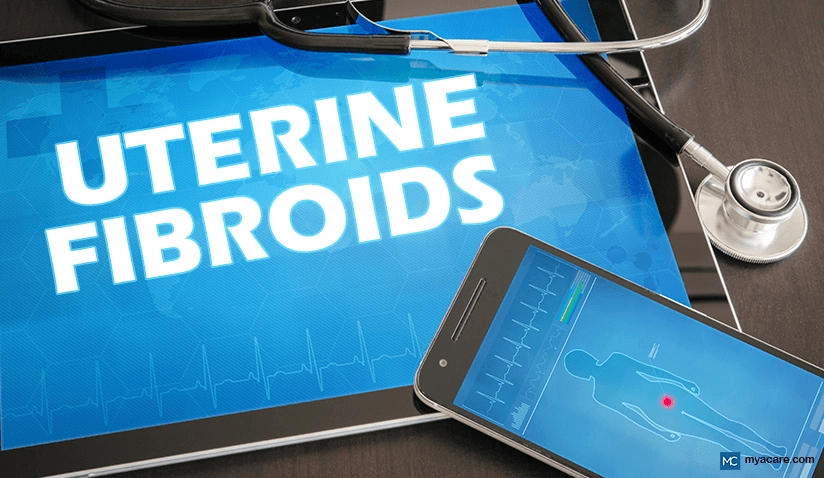Uterine Fibroids: What You Need to Know to Make Informed Decisions

Medically Reviewed by Dr. Sony Sherpa, (MBBS) - August 19, 2024
Uterine fibroids are benign growths in or on the womb (uterus) that affect approximately 20-40% of women, usually during their childbearing years.
Also known as uterine leiomyomas or myomas, these growths are the most common tumors of the female reproductive tract. They are hardly ever malignant and are not correlated with an increased risk of uterine cancer.
Uterine fibroids vary in size, shape, and location, and may come and go.
Types of uterine leiomyoma are classified according to their location:
- Intramural fibroids are found inside the muscle tissue of the uterine wall.
- Subserosal fibroids are found under the skin on the outside of the uterus (not in the cervix).
- Submucosal fibroids are found beneath the uterine lining inside the uterus.
- Pedunculated fibroids refer to those that grow on stalks attached to the uterus.
What Causes Uterine Fibroids?
While the precise cause of uterine fibroids is unknown, some factors may influence their development. These include:
Hormones: During each menstrual cycle, estrogen and progesterone stimulate the development of the uterine lining. If the levels are too high or low, these may promote fibroid growth. Women are at a greater risk near menopause or during perimenopause. Fibroids may also develop during or after pregnancy due to hormonal fluctuations.
Growth Factors: Insulin-like growth factor I and II, as well as epidermal growth factor, have been associated with fibroid growth. These are intricately connected with reproductive hormones, cortisol, inflammation, diet, and blood sugar control.
Genetics: Fibroids may have changes in their genes that vary from those in normal uterine muscle cells. These changes may be due to environmental exposures, other risk factors, or hereditary genetics.
Vitamin D Deficiency: Vitamin D3 regulates the division and growth of cells in the uterus. Across studies, deficiency has been linked to fibroid formation, and women with uterine fibroids are more likely to be deficient.
Ethnicity: Over the years, studies have shown that women of African descent have a greater risk for developing uterine fibroids as well as a higher risk of early onset. The link between black women and fibroids may be due to specific genetics that contribute to vitamin D3 deficiency.
Other factors: Obesity, diet, stress, infection, inflammation, or environmental toxins are all linked with an increased risk of fibroid formation.
View Doctors Treating Uterine Fibroids
Signs and Symptoms of Uterine Fibroids
Up to 75% of women with uterine fibroids have no symptoms or only mild symptoms.
Signs and symptoms of uterine fibroids might include:
- Heavy or irregular menstrual bleeding
- Prolonged menstrual periods (more than a week)
- Pelvic pain or pressure
- Frequent urination or difficulty emptying the bladder
- Constipation or bloating
- Backache or leg pain
- Infertility or recurrent miscarriages
Fibroid Degeneration
If fibroids develop rapidly or to a large enough size, they may degenerate. Fibroid degeneration happens when the fibroid outgrows its blood supply, causing it to break down. While this can be positive, it often causes pain and worse symptoms while the fibroid is cleared from the body. Fibroid breakdown is one of the main complications associated with uterine fibroids and is most common during pregnancy.
The following could be signs of fibroids breaking down:
- Fever and nausea or vomiting
- Severe pain or bleeding that requires emergency care
- Anemia (low red blood cell count) due to heavy blood loss
- Urinary tract infections or kidney damage due to pressure on the urinary system
- Infection or inflammation of the uterus due to necrosis (tissue death) of a large fibroid
When treating fibroids, it is important to distinguish between fibroid breakdown or degeneration and the actual shrinking or removal of fibroids. Fibroid degeneration is diagnosed and treated separately from intact fibroids, as they do not respond to ordinary treatment options.
How Are Fibroids Diagnosed?
To diagnose uterine fibroids, your doctor may ask about your medical history, symptoms, and menstrual cycles. A physical exam is used to check the size and shape of the uterus and feel for any lumps or masses.
Tests may be required to confirm the diagnosis and evaluate the condition of the uterus. These may include:
- Ultrasound: A painless and non-invasive test that uses sound waves to create images of your uterus and other pelvic organs. It can show the location, size, and number of fibroids.
- Hysteroscopy: This procedure involves inserting a thin, lighted instrument (hysteroscope) through the cervix to examine the uterus for fibroids or other abnormalities.
- Laparoscopy: A minimally invasive surgery that involves making a small incision in your abdomen and inserting a thin, lighted instrument (laparoscope) to see inside the uterus. It can be used to remove degenerated fibroids or other tissues that may be causing problems.
- MRI: Imaging technology that makes use of a strong magnetic field and radio waves to create detailed pictures of internal body compartments. It can help your doctor plan a fibroid surgery or other treatment options.
Treatment for Uterine Fibroids
Concerning uterine fibroids, treatment depends on several factors, such as:
- The size, number, and location of your fibroids
- Your age and reproductive plans
- Your symptoms and how they affect your quality of life
- Your preference and general health
Some possible treatment options include:
Watchful Waiting
This means monitoring your condition with regular check-ups and tests without any active treatment. This may be an option if you have no symptoms or mild symptoms, are pregnant, or are close to menopause (when fibroids tend to shrink).
Medication
Medications are often used just as a temporary measure to control pain and excess bleeding as needed. They may spontaneously resolve symptoms, doing away with the need for surgery or other serious treatment options.
The following types of drugs can help reduce symptoms of uterine fibroids:
- Painkillers
- Anti-inflammatory drugs
- Birth control pills
- Hormonal injections
- Intrauterine devices (IUDs) that dispense hormone or medication
New types of uterine fibroid medication can temporarily shrink the size of fibroids. These include gonadotropin-releasing hormone (GnRH) agonists or selective progesterone receptor modulators (SPRMs). It is best to consult with your doctor beforehand, as medications for uterine fibroids may have side effects, limitations, and contradictory effects, such as promoting fibroid degeneration. Fibroids can also grow back after stopping medication.
Surgery
Different types of uterine fibroid surgery are discussed below as follows:
Myomectomy is a form of fibroid removal that preserves the uterus. A myomectomy may improve fertility and reduce symptoms, yet it also poses risks of bleeding, infection, scarring, or fibroid recurrence. Some studies suggest that women with myomectomy experience a better life quality years after the procedure, compared to uterine artery embolization.
The procedure can be done through:
- An open abdominal incision (abdominal myomectomy).
- Small abdominal incisions using a laparoscope (laparoscopic myomectomy).
- The vagina and cervix using a hysteroscope (hysteroscopic myomectomy).
Laparoscopic myomectomy is the gold standard for treating a degenerated fibroid, which often does not respond well to other types of surgery or treatment, such as uterine artery embolization.
Hysterectomy removes the entire uterus, with or without the ovaries and fallopian tubes. It is the only “permanent cure” for uterine fibroids, yet typically leads to early menopause. Hysterectomy risks include bleeding, infection, damage to nearby organs, and hormonal changes.
Non-Invasive Procedures
The following fibroid removal options are minimally invasive, requiring no incisions to perform.
Uterine Artery Embolization (UAE) involves injecting small particles into the blood vessels that supply the fibroids, causing them to shrink and die. This blocks their blood supply and ultimately causes the fibroid to shrink. This process is not the same as fibroid degeneration and is used to control symptoms of heavy bleeding. While it is one of the most effective treatment options for those wishing to avoid surgery, it can pose risks of complications, including infections, pain, and very rarely, fibroid breakdown requiring surgical removal.
Focused Ultrasound Surgery (FUS) is a non-invasive procedure that uses high-intensity sound waves to heat and destroy fibroids. Ultrasound for fibroids is a great option for women still wishing to plan for pregnancy, as it is associated with the least risk for complications that interfere with fertility. One may have to repeat the procedure several times for the best results. Complications of this procedure may include skin burns, urinary tract infections, and nerve damage.
Can Fibroids Be Shrunk or Treated Without Surgery?
It is not yet clear how to shrink fibroids or treat them without surgery, embolism, or ultrasound treatment. There is a growing body of research that suggests it may be possible to get rid of fibroids without surgery, although using non-surgical methods is unlikely to be a quick process that can alleviate urgent symptoms immediately. Women with severe symptoms ought to consult with a healthcare professional and get treatment as soon as possible.
The research serves to clarify the causes of fibroid growth, highlighting dietary and lifestyle changes that can help to correct the underlying problem. These may be useful in preventing fibroids in the future and managing one’s state of health after fibroid removal or treatment.
Fibroid Management and Prevention
The following suggestions may help to prevent fibroids in women at risk or who wish to minimize their recurrence.
Dietary Considerations
There are no strict dietary recommendations for managing fibroids. However, it may be practical to consume a diet that emphasizes hormonal stability, blood glucose control, and lower inflammation levels, and which does not promote growth factors, such as insulin-like growth factor. A healthy microbiome has also recently been highlighted as vital for preventing fibroids due to its role in regulating inflammation and hormones.
Focus on consuming plenty of fiber-rich fruits, vegetables, whole grains, lean proteins, and moderate amounts of healthy fats from nuts and seeds. Some foods that may be especially beneficial include:
- Green leafy vegetables
- Cruciferous vegetables such as broccoli, cabbage, and cauliflower
- Carotenoid-rich foods
- Legumes
- Turmeric
- Ginger
- Fish oil
Seeds and certain foods high in phytoestrogens, such as soy, should be consumed in moderation and may not be recommended on a daily basis.
Studies suggest that women with fibroids have difficulty excreting lignan, which is an estrogenic component of seeds. Flaxseeds and chia seeds may be better options for this part of the diet as they are mucilaginous (aiding digestion) and higher in omega-3 content (which makes fish oil desirable). Soluble fiber in prebiotic foods is vital for maintaining overall hormone metabolism.
It is advisable to avoid red meat, processed meat, dairy products, refined carbohydrates (such as white bread and pasta), sugar, alcohol, and caffeine. These can increase growth factors, stress hormones, and inflammation, and destabilize blood glucose levels. Probiotic-enriched dairy products in moderation may be tolerable, although dairy is known to have a high estrogen content.
Natural Remedies for Uterine Fibroids
Some women may prefer to try natural remedies for uterine fibroids, such as supplements. Taking certain supplements may help improve hormonal balance and reduce inflammation. Supplementation is considered a uterine fibroid supportive therapy for women wanting to manage or prevent them.
The primary supplement for fibroid management is vitamin D3. Research suggests it may even be a ‘natural cure’ for fibroids, capable of inhibiting their growth and shrinking their size in experimental studies. These effects have yet to be confirmed in human trials, although it is a well-known fact that women with fibroids are commonly deficient.
Other supplements that may be helpful include:
- Vitamin B complex that includes the active form of vitamin B6 (P-5-P)
- Magnesium
- Zinc
- Selenium
- Omega-3 fatty acids
- Curcumin (from turmeric)
- Green tea extract
- Chasteberry extract (also known as vitex)
- Black cohosh extract
Vitamin E might be recommended, yet alpha-tocopherol, a common form of vitamin E, ought to be avoided due to its association with fibroid development.
Consult with your doctor before taking any supplements to avoid any interactions or adverse effects.
Lifestyle Changes
Lifestyle changes may be necessary to help reduce stress, regulate hormone metabolism, and improve blood circulation.
Some lifestyle changes that may be beneficial include:
- Daily sun exposure during the morning and late afternoon.
- Exercising regularly for at least 30 minutes a day.
- Practicing yoga or meditation to relax your mind and body.
- Getting enough sleep, between 7-9 hours a night.
- Quitting smoking, as it can increase hormonal imbalances and inflammation.
- Avoiding exposure to environmental toxins such as pesticides, plastics, air pollution, and harsh chemicals.
Conclusion
Uterine fibroids are common benign tumors of the uterus that cause severe symptoms in some women. There are many uterine fibroid treatment options available that can cater to individual circumstances and preferences. Women with severe symptoms ought to seek medical attention and treatment immediately. Dietary considerations, lifestyle changes, and natural remedies may help to prevent or shrink fibroids at home, although more research is required to confirm their efficacy. It is essential to consult with a doctor before starting any treatment or remedy to ensure its safety and effectiveness.
To search for the best Obstetrics and Gynecology healthcare providers in Germany, India, Malaysia, Poland, Saudi Arabia, Singapore, Slovakia, Spain, Thailand, Turkey, the UAE, the UK and the USA, please use the Mya Care search engine.
To search for the best doctors and healthcare providers worldwide, please use the Mya Care search engine.
The Mya Care Editorial Team comprises medical doctors and qualified professionals with a background in healthcare, dedicated to delivering trustworthy, evidence-based health content.
Our team draws on authoritative sources, including systematic reviews published in top-tier medical journals, the latest academic and professional books by renowned experts, and official guidelines from authoritative global health organizations. This rigorous process ensures every article reflects current medical standards and is regularly updated to include the latest healthcare insights.

Dr. Sony Sherpa completed her MBBS at Guangzhou Medical University, China. She is a resident doctor, researcher, and medical writer who believes in the importance of accessible, quality healthcare for everyone. Her work in the healthcare field is focused on improving the well-being of individuals and communities, ensuring they receive the necessary care and support for a healthy and fulfilling life.
Sources:
Featured Blogs







